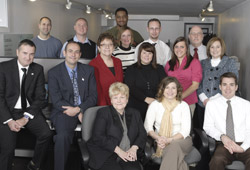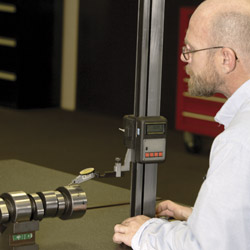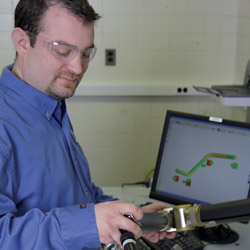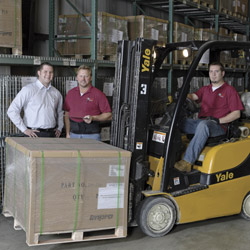
Pierre Lewin and Patrick Peronnet are co-founders of Supply Chain Services International (SCSI). As president and vice president, Lewin and Peronnet have worked together for 13 years, and their roles within the company are interchangeable. With the corporate office located in Peoria, the company has 13 locations in the United States, with offices in China, Belgium, France and Romania.
Please provide some basic biographical information for you both.
Pierre Lewin is 38 years old, married with two children. He holds a bachelor’s degree in manufacturing and production, and an MBA in international trade. His professional career started in 1995 as an export sales manager for a French machine shop. In 1998, he assisted in the start-up of a new machine shop in France and moved to the United States as international projects manager. Lewin partnered with Patrick Peronnet in 2001 to form SCSI to offer local support to overseas suppliers in the logistics and quality areas.
Patrick Peronnet is 43 years old, with one daughter. He has a bachelor’s degree in manufacturing and production and an executive MBA. His professional career started in 1988 as computer tech support at Novell Networks. He then became quality manager of a machine shop in France and was promoted to plant manager in 1994. In 1998, he was founder and president of a start-up French machine shop. In 2001, he co-founded SCSI in Peoria and migrated to the U.S.A. in 2006. How did the two of you meet? When and under what circumstances did you come to Peoria?
How did the two of you meet? When and under what circumstances did you come to Peoria?
In 1995, Pierre was working for Renault Industrial Vehicles, a Scandinavian sales organization. At the same time, a French machining company was looking for an export sales engineer to continue developing its foreign customer diversification efforts. Patrick was the joint facility manager of this machining shop and interviewed Pierre for this position. As both of us had been at the origin of the company’s export efforts, we met during the interview. Close in age, given immense latitude to conduct business as we saw fit, and sharing the same enthusiasm for new ideas, we rapidly started working together on major projects.
One of the cornerstones of export sales was Caterpillar Belgium. During the mid-90s, in an effort to combine volumes and reduce cost, Caterpillar Mossville Purchasing visited our facility. Common components to both Gosselies, Belgium and Mossville offered the opportunity to single-source and thus started our supply to the USA. Progressive in its supply chain activities, CAT Mossville introduced us to the concept of vendor-managed inventory and to a local third-party logistics company. After a few years of steady business and quarterly visits, we agreed with Caterpillar to drastically increase our volume of business. Given the scope and size of this opportunity, it was necessary to strongly focus our efforts and resources to ensure success. A local presence was inevitable, at first in person to manage the project and be totally dedicated to Caterpillar’s needs (1998), and then physically, with a facility (2001) to enhance our customer service performance in the areas of logistics, quality and engineering. SCSI was born, a vertical integration of our supply chain offering Caterpillar local service from an overseas manufacturing plant.
How did the idea for SCSI originate? How did the company get its start?
Funnily enough by failure! Originally, this huge Caterpillar opportunity included the start-up in France of a machine shop for large castings. This choice was justified at the time by competitive European foundry capabilities. The next step was the creation in the U.S.A. of another machine shop, this one specialized with higher volumes and smaller components, where, there again, local foundry sources for those components were more competitive. Revenue for the U.S. entity was to come from the French start-up. Unfortunately, in 2002 forecasted volumes did not materialize and consequently delayed our U.S. start up. When volumes picked back up several months later, the opportunity had passed us by. Patrick and I decided at that point that we still needed a U.S. presence to build and support our U.S. customer base, and that it would be easier, cheaper and safer to start with warehousing and distributing our parts ourselves, versus the third-party logistics partner originally used. The idea of SCSI was born.
We looked at the current supply chain, our 3rd party logistics services, how we were performing, and what changes and improvements could be made. Current costs were identified; it simply became a matter of establishing how to do it better and cheaper!
Describe the company’s mission. How do you add value to the supply chain for your customers?
Our current mission statement reads: “Provide superior quality supply chain solutions and services to the industry worldwide with accurate, reliable, and timely processes, information, and people.”
Because we are within the supply chain, we have two types of customers: suppliers and OEMs. As a consequence, we have organized ourselves to respond and focus to the specific needs of both. Because we were originally a supplier, we had a pretty good idea of what those needs are. Understanding the OEMs was trickier, and in retrospect, one of our best decisions was to include CAT retirees in our founding members. Having an in-house supplier and final customer knowledge is a tremendous asset, as it allows us to internally identify, recognize and anticipate the needs of both types of customers.
To add value, we strive when developing solutions to ensure they adhere to our driving philosophy of “low maintenance.” All too often, services are sold to address 95 percent of the needs, but when events or situations are slightly out of scope, the provider has not foreseen them and is unable to respond. We build in the flexibility to resolve the exceptions and do whatever it takes to service the customer. Everyone has experienced the frustrations of a call center, out of working hours, or an impersonal response claiming that it is not their responsibility. We strive to be different.
In our mind, those exceptions provide us with the opportunity to show our value. As a result, for every solution or process we establish, such as “FMEA” (Failure Mode Effect and Analysis), we also have contingency plans in place in the event failures occur. Combined with employees that are committed and take ownership of these processes, we offer the support the customer might not have expected, but is pleased to find.
A simple example: in our logistics activities, we store overseas supplier material. Instead of waiting for inventory levels to run out, we monitor the pipeline and take action directly with the supplier to avoid shortages to the final customer. The final customer need not worry about his supplier running out of product and incurring costly premium freight. SCSI minimizes the risk of shortage and as a result creates a low-maintenance relationship between him and the supplier. The supply chain costs and savings identified early on in the project are safeguarded providing each and every party involved receives the best overall competitive supply chain solution. How do you scale or customize your services according to customers’ needs?
How do you scale or customize your services according to customers’ needs?
Each service or solution we provide is tailored specifically to each situation, as no project is the same. Depending on the scope of the project, a discovery or information-gathering phase is established. Over time, we have identified recurring tools and processes that we continue to improve (systems, checklists, gages, etc.)
As for scalability, our entire organization is built on the flexibility of our workforce. In the service industry, your “output” is closely related to your workforce, and therefore, when engaging with our customers, we recognize the need to reduce costs to a minimum and design our solutions accordingly. Labor becomes the variable factor to size the required services.
As the company has grown, how has your business model evolved, if at all? How is the SCSI of 2001 different from the SCSI of 2009?
In 2001, we started with three people and operated day to day. Little by little, our customers recognized the overall value of our work and presented us with additional opportunities. For the next three to four years, we reacted to opportunity. As we continued to grow, it became necessary to organize and structure ourselves in order to sustain and improve our current level of services and plan ahead. We are constantly making progress towards our long-term strategy.
The other significant change is that in 2001, we were a miniscule company and our customers knew it. Today our customers view us and set expectations as if we were a large global company. We take pride that they do so, and it is all the more motivation and drive to deliver to their expectations.
What has not changed since the beginning is the continued involvement, dedicated ownership and drive of our employees to enhance our company’s offerings. We recognize this commitment as a key to our current success.
How do quality initiatives like Six Sigma play a role in the services you provide?
Externally, our customers have embraced Six Sigma or similar tools, especially in more complex projects. We have benefited greatly from this approach and methodology as it defines, structures, prioritizes and sets goals for each of the projects we are involved in. As explained above, an all-encompassing, detailed and planned approach identifies the value of our services and justifies our involvement.
Internally, we have kept that same strong culture of continuous improvement that we adopted at our inception and numbers of our employees have been formally trained.
What containment activities are provided by SCSI when problems occur in the supply chain? Describe a case in which a customer required local representation to resolve a quality problem.
We perform a variety of services ranging from simple sorts to salvage and rework operations, be they on-site at the end customer, on stored material, or upstream at our supplier-customer’s facilities, even overseas. Given the random or unexpected nature of quality issues, we have staffed and tooled up to internally handle a vast majority of recurring defects such as rust, cleanliness, paint and dimensional issues. For more complex, less frequent issues that do not justify capital expenditure in dedicated equipment, we have established a network of local subcontractors who we task to execute the work. Again, we take ownership of the situation, coordinate, and manage the subcontractor on behalf of our customers, providing a “one-stop shop,” low-maintenance solution. To date, we have provided these services to more than 250 customer/suppliers across the world, some once and others regularly!
One of the most extreme cases we came across was an overseas supplier who continues to thank us to this day for our intervention due to its potential negative financial impact. Notified by the end customer on the assembly line, we dispatched within minutes our “first responders” to assess the situation and provide immediate temporary relief and minimize the end customer’s “pain.” The priority in these situations is to quickly identify a sorting criterion to keep the end customer production running. Unfortunately, the nature of the failure was making this task difficult.
Given the time constraint, we proceeded, based on our technical knowledge, to establish, sort and segregate following several criterions. When the end customer established the acceptable sorting criteria, we had already encompassed it within our initiative. By doing so, we gained precious time and were able to continue to feed the assembly line with material to avoid a production shutdown. As we progressed in our containment, it was clear that a very high percentage of material was non-conforming, and extended far upstream into the supply chain. The financial impact of this situation was valued in the millions between line interruptions, scraped product, reproducing, premium freight, etc., and the supplier/customer was struggling to find a fix. We worked diligently using our technical expertise and came up with a rework process acceptable to the end customer that would salvage a vast majority of the product.
The advantage of being on-site, close to the end customer’s engineering and quality departments proved invaluable. As a result, minimal pain was caused to the end customer; the supplier/customer cost of poor quality was limited. A severe situation was averted. Our containment team can execute similar tasks day after day, around the clock.
How does SCSI leverage technology in its quality and logistics services?
In our previous experience in manufacturing, we strongly invested in technology, as we saw the quality and productivity gains far outweighed the hassle of maintenance and dealing with the consequence of inefficiencies. This approach requires strong financial commitment and finds reward over time by sustaining performance long term. In our current activities, we have not changed our approach and bring this strong investment experience into our services.
Given the global nature of SCSI’s logistics activities, we have strongly invested in and emphasized communication systems and tools offering A.R.T. (Accurate Reliable Timely) data for inventory levels, material tracking and advanced shipping notices and costs.
In our quality services (AQS), not only have we followed the same strategy for information systems, we are making significant investments in state-of-the-art measurement equipment and gauging. Throughout our locations, we use some of most precise coordinate measuring machines in the world, optical and laser measuring machines, multifunctional gauging, etc.
We choose these high-dollar assets, making sure they are accurate and reliable, but also that they offer the highest levels of productivity. Our CMMs are currently the fastest in the world, and we ensure that they are constantly being utilized. Technology, often costly, is only justified if it produces more!
As co-owners, how do you share responsibilities? How are your roles different within the company?
As a small company, the lines of responsibility between us are not precisely defined, and in effect we are interchangeable. This provides back-up, availability and flexibility. That being said, we do have our areas of expertise and will decide case by case where each of us should focus to maximize the efficiency of our work. Currently, one of us manages the European expansion, while the other works on China. Our working relationship has proven over time that one brain plus another brain equals three or more. We emulate each other and take immense satisfaction in working together and would not want it any other way.
With customers in North America, Europe, India and Asia, SCSI is truly a company with global reach. What have been the most important factors that have contributed to your success in this highly competitive global marketplace?
The U.S.A., Caterpillar, our employees and perspiration!
After coming to the U.S.A. and being exposed to the American culture, we believe this country is the best place in the world for us. The drive, work ethic, environment and character of the Americans make anything and everything possible. We have yet to come up with a challenge our employees have not embraced. From our many travels, we have yet to find such a business-friendly environment. Therefore, having “jumped the pond” as our first step towards the U.S.A., anywhere else would be easier from this base. There is also no doubt whatsoever that our customers have provided us the opportunity to support them globally and, as a consequence, open other doors for us to expand. We are currently planning a physical presence in South America and Eastern Europe, more in Europe and Asia, and one day, India.  What challenges are unique to an international company?
What challenges are unique to an international company?
Everyone grasps the challenges of cultural differences. Different language, different time zones, distances, different laws… but all of these aspects are manageable; the true challenge is to understand the culture in a general sense. What motivates a Chinese worker? How do you train a Romanian worker? How do you work with a French customs officer? How long does a decision process take in England? What is long term for an Indian worker? Learning a language or hiring a translator only gets you so far, but understanding and embracing those culture differences is invaluable.
What advice do you have for a local company who wants to go global?
Contact SCSI! Seriously! We have developed a network distribution that can deliver across the world and provide quality inspection outbound or inbound.
For a global company, what are the pros and cons of being located in central Illinois?
Pros: Proximity to our major customer has been essential to our growth. Additionally, the support from local government, institutions and then the network and access to services such as banking, accounting, and legal services has been excellent.
Cons: From a practical standpoint, traveling from Peoria adds four to five hours to any international trip. A direct flight from Peoria to Shanghai would be nice!
When it comes to business resources, we struggle some in finding internationally experienced management and legal/fiscal advice and have had to seek this help from larger pools of expertise in Chicago or St Louis.
On a side note, we are currently working with the EDC on promoting technical and support services to enhance local businesses and attract new capabilities to this area.
What is the outlook for SCSI’s future growth? How has the current economic downturn impacted the company?
We are continuing to expand globally our current services into China, Europe and plans for South America, as well as other states in the U.S.A., including Illinois. Given our increased coverage, we are looking to increase our diversification efforts, both in terms of services, industries and customers.
Pertaining to the downturn in the economy, there is no doubt that our rate of growth will be negatively impacted. At the time of this interview (December 2008), volumes in our logistics activities, especially related to the automotive supply, have decreased or anticipate reduction, with much uncertainty for 2009. This being said, our business model since inception has been designed to contract and expand based on needs and market cycles. Flexibility has been a key for us in growth and will prove invaluable in a downturn. Given that we are embedded within the supply chain, we remain confident that the level of quality and performance of our services will continue to procure added value at the best overall cost and solidify our relationship with our customers through these challenging times.
Anything else you would like to add?
As mentioned before, our employees are an important asset to the success of our company. In today’s rapidly changing world, employees have options when choosing an employer. We can offer opportunities for career growth. Our philosophy is centered on creating a culture that reinforces our core values of Integrity, Respect, Performance, Accountability and Commitment. We continually keep a watchful eye out for individuals who value these qualities and would be a great addition to our dedicated team. iBi

